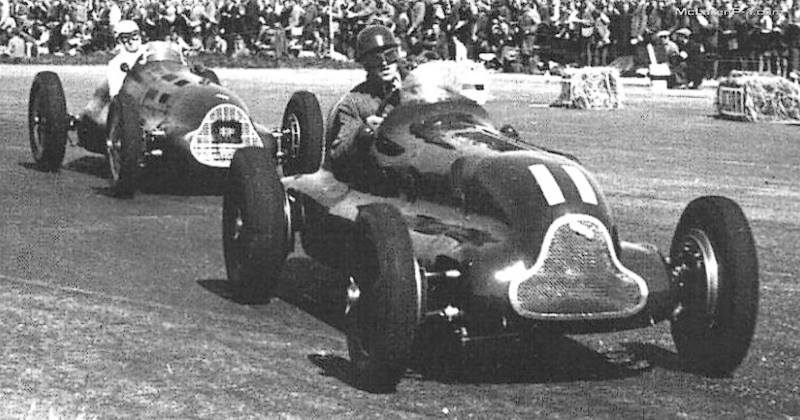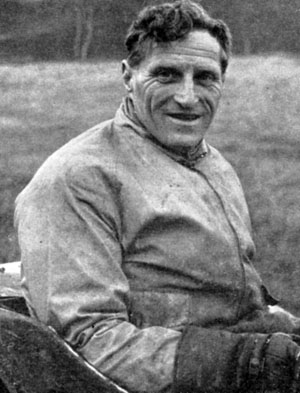Cuth Harrison born Thomas Cuthbert Harrison (6 July 1906 – 21 January 1981) was a British racing driver from England.
He was born in Ecclesall, Sheffield, and also died in Sheffield. He participated in 3 World Championship Formula One Grands Prix, debuting on 13 May 1950. He scored no championship points. He founded the T.C.Harrison Ford dealership. Info from Wiki
Bio by Stephen Latham
Thomas ‘Cuth’ Harrison only contested 3 World Championship Grands Prix but he enjoyed considerable success in trials and speed events in the late 1930s and became a front runner with his ERA after the War plus was part of Ford’s Rally team.
Born on the 6th July 1906 in Ecclesall, Sheffield, before he started racing he entered the motor trade in 1931 when he opened a small repair shop. His introduction to motor racing started in 1934 at Donington Park, where he raced a Ford 8hp touring car, which he had converted into a single seater racing car. In 1937 he contested a 12 Hour Donington event with his Riley and the following year finished ninth in the TT and fifth in Donington’s Coronation Trophy.
He resumed racing after the War with his Riley, competing at Grandson Lodge in 1946, though by this time he had also bought the ex-Richard Seaman ERA R1B and Earl Howe’s R8B, which started his long association with the ERA. Sharing an ERA with Bob Gerard in 1947 he was third at the Marne GP and fourth in the European GP at Spa and he had a fourth place in the Ulster Trophy and ninth in the Empire Trophy. He also contested the Blackpool Rally with Ford and took a class win while outings with the Riley saw a second place in the Manx Cup and fifth in a Formula Libre race at Ballyclare and at a National meeting at Tholtorpe in the September he had a win, a second and fourth with a Riley 6 and Riley Sprite.
The following year saw retirements in the British and Monaco Grands Prix, due to a broken valve and engine failure but he went on to take third and fourth in the Ulster Trophy and Empire Trophy races. Back in the Riley, although he retired from the Manx Cup, he was second in the Bisley Trial and won the Sheffield and Hallam Trial, the NMMC and Jeans Gold Cup trials plus his own Harrison Trial. Continuing with the ERA in 1949 he retired due to engine failure at Silverstone though was sixth in the Italian GP and went on to take third place in the Woodcote Cup and Richmond Trophy and fourth in the Empire Trophy. In Trials events he was second in the High Peak and third on the Sheffield and Hallamshire.
His R8B was updated to ‘C’ specification and fitted with a Rootes supercharger and 1950 saw his World Championship debut, contesting three races. He made his debut at Silverstone where he qualified fifteenth and finished seventh but retired on his return to Monza for the Italian GP. His race at Monaco unfortunately ended early when he was one of the drivers who was caught up in the first lap crash. On the race’s opening lap, a wave from the harbour flooded the track at Tabac and Farina, who was second, spun into the wall before bouncing into the paths of the oncoming cars. Only nine cars were eventually left to continue with the race though they were forced to navigate around the wrecked cars for a number of laps. Continuing with the ERA he finished third and fourth in the Ulster Trophy and Silverstone’s International Trophy plus took second in the British Empire Trophy on the Isle of Man behind Bob Gerard’s similar ERA. In trials events he took victories in the Kitching, Yorkshire Trophy, Wilson Trophy, Thomas Cup and the Gloucester Trial plus second in the North Midlands Autumn and finished second in the RAC Trials Championship.
1951 saw him go one better than the previous year’s result when he became the RAC Trials Champion, taking wins on the Kitching, the Gloucester Trials, the High Peak and TV Wendover Trial plus second on the Yorkshire. He also finished twelfth in a Ford Zephyr in the Monte Carlo Rally plus was seventh in the Rally Automovel Int. de Lisboa-Estoril. He began concentrating on establishing his Ford dealership though continued competing in trials with his self-built Ford-based specials known as Harfords and remained a member of the works Ford’s rally team until the early 1960s. In 1952 he was again RAC Champion and was runner up with his Harford in the BTRDA Series plus took wins and team prizes when racing with his two sons, Edward and John. There was a fourth place in the RAC British International Rally with his son Edward at the wheel of a Ford Zephyr and he was twelfth in the Monte Carlo Rally. As part of the Ford team he was third in 1953’s RAC Rally plus added the team prize and a class win. He retired from that year’s Alpine and Tulip events but finished thirteenth in the Monte Carlo Rally and in Trials events won the Davis Trophy. There were class wins the following year on the Tulip and RAC Rallies, plus trialing awards, but in 1955 he sustained a broken leg while doing Winter sports in Switzerland. Although it forced him to miss part of the season he did take a seventh class placing in the Rally of the Midnight Sun and the Criterium des Alpes events plus in trials drove his Harford to a class victory in the Sanford Sprint.
He was also able to compete in 1955’s running of the Monte Carlo Rally and Cuth and most of the British drivers started from Glasgow while others’ starting points were at Athens, Lisbon, Monte Carlo, Munich, Oslo, Palermo and Stockholm. A Star newspaper report wrote how “the official Ford team are using an “electric brain”, officially known as an analogue counter, which should help a lot in the regularity tests. This device records on a speedometer type dial, the average speed over a given distance, and makes proper allowance for any stops.” After leaving Glasgow the drivers headed to Stranraer and then on to Doncaster and Dover but even before reaching Europe, the conditions in Britain facing them were as difficult as had been known, with long stretches of the route covered with snow and treacherous icy surfaces. It was believed the rally would probably be won and lost in the difficult Gap section of the Maritime Alps, where regularity tests would be held on a secret route. The competitors would face tests at Monte Carlo, where the most successful drivers in the road section would take part. There would be acceleration and braking tests and the following day the best hundred drivers would face a regularity circuit through the mountains. On the day after, they would undergo a speed test around the Grand Prix circuit, followed by five more tests and the concours would be held after all the tests were completed. Cuth eventually finished eighteenth with the Zephyr.
He and John were seventh in 1956’s Rallye International des Alpes and alongside his win at 1958’s White Rose Trial, he also claimed the team prize as his sons finished second and third. 1959 saw him contest the first running of the Internationale Tulpenrallye (The Tulip Rally) and also the Coupe des Alpes with John. He was part of 1960’s team prize winning Ford squad in the Safari Rally and in the following years he was seventh on his return to the Safari Rally, won the Stone Trough Trial plus took class awards on the Rotherham Centenary and Derbyshire Trials events. His final years included the RAC Trials Championship in 1963 and in 1964 he was fourth in the Chase Cup, fifth in the Yorkshire Trials and sixth in the Stone Trough Trials.
Cuth passed away in Sheffield on the 21st January 1981 though the company he founded remains successful to this day and runs a number of dealerships.

Gallery F1




